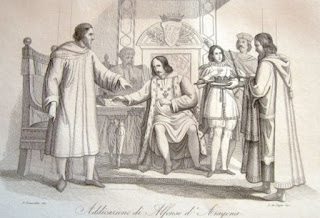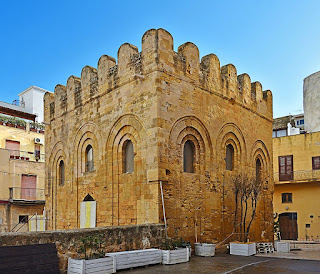Ruler forced to abdicate after one year
 |
| Alfonso II became King on the death of his father in 1494 |
Also known as Alfonso II of Aragon, as heir to Ferdinand I he had the title Duke of Calabia from the age of 10. Blessed with a natural flair for leadership and military strategy, he spent much of his life as a condottiero, leading the army of Naples in a number of conflicts.
He contributed to the Renaissance culture of his father’s court, building the splendid palaces of La Duchesca and Poggio Reale, although neither survived to be appreciated today.
Alfonso II also introduced improvements to the urban infrastructure of Naples, building new churches, tree-lined straight roads, and a sophisticated hydraulic system to supply the city’s fountains.
He became King of Naples with the death of his father in January 1494 but stepped down in favour of his son, Ferdinand II, in January the following year as the powerful army of Charles VIII of France, who had launched an invasion of the Italian peninsula in September, 1494, prepared to take the city.
Alfonso fled to Sicily, seeking refuge in a monastery at Mazara del Vallo on the southwestern coast, about 25km (15 miles) from Marsala in the province of Trapani. He died there in December 1495 at the age of 47.
The eldest son of Isabella de Clermont, the first wife of King Ferdinand I, Alfonso II inherited the title of King of Jerusalem on his mother’s death. After being given a humanist education from tutors in his father’s court, he became a career soldier.
 |
| A drawing depicting the scene of Alfonso's abdication in favour of his son, Ferdinand II |
Other notable campaigns included the war waged by the Kingdom of Naples and Pope Sixtus IV against Florence following the attempt by the Pazzi family to assassinate Lorenzo de’ Medici in 1478, the reversal of the Ottoman invasion of Otranto in 1481, and a major intervention against Venice in the War of Ferrara, also known as the Salt War, between 1482 and 1484.
Closer to home, he advised his father to impose severe repressive measures to crush the so-called Conspiracy of the Barons in 1485, which made him many enemies.
By the time Alfonso ascended to the throne in Naples with the death of his father, the Kingdom’s coffers were exhausted and the chances of repelling the armies of Charles VIII were much reduced. The French king had been encouraged to attack Naples by Alfonso’s brother-in-law, Ludovico Sforza, who saw a chance to reassert his power in Milan.
Pope Alexander VI tried to persuade Charles VIII to use his resources against the Turks instead but without success. By early 1495, Charles was approaching Naples, having defeated Florence and the Neapolitan fleet under Alfonso's brother, Frederick, at Porto Venere, at which point Alfonso took flight, handing power to his son, Ferdinand II, who offered no resistance as Charles VIII seized the crown on behalf of his father, Louis XI, who had inherited the Angevin claim to Naples.
 |
| A bust at the Victoria and Albert Museum in London, said to be of Ippolita Maria Sforza |
Of Alfonso’s two major villas in Naples - La Duchesca and Poggio Reale - the latter, a complex said to have been designed by the architect Giuliano da Maiano, was said to be so beautiful that Charles VIII described it as an “earthly paradise”.
Located in a district now known as Poggioreale, the Poggio Reale complex fell into disrepair after Charles had left, taking many of its treasures back to France. In the 17th century, an attempt was made to restore it under King Philip III of Spain but a resurgence of bubonic plague put paid to that, and part of the grounds became a burial place for lepers. Ultimately, a cemetery was built on top of the ruins.
After his death in Sicily, Alfonso’s remains were buried at the Duomo di Messina, the Cathedral Basilica of Santa Maria Assunta.
 |
| The Norman church of San Nicolò Regale in Mazaro del Vallo, built in 1124 |
Mazara del Vallo, where Alfonso II sheltered after fleeing Naples, is a port and resort at the mouth of the Mazara river on the southwest coast of Sicily, 25km (15 miles) from Marsala and just over 130km (80 miles) from the island’s capital, Palermo. Founded by the Phoenicians in the ninth century BC, it has passed under the control of the Greeks, Carthaginians, Romans, Vandals, Ostrogoths, Byzantines, Arabs, Normans, Angevins, Catalans, Savoys, Habsburgs and Bourbons before being conquered by Giuseppe Garibaldi in 1860 and joining the newly-formed Kingdom of Italy. Attractions include the remains of a Norman Castle built in 1073 and demolished in 1880, the church of San Nicolò Regale, which is a rare example of Norman architecture, built in 1124, and the simple church of San Vito a Mare, built in 1776 on the site of old Norman remains on the edge of the water. Arab influences can be enjoyed in the historic Kasbah Mazara del Vallo district, while the Museo del Satiro Danzante houses a bronze statue of a dancing satyr believed to have been sculpted by Greek artist Praxiteles, which was found at a depth of 500m (1,600 ft) in the Strait of Sicily by a fishing boat in 1998.
 |
| The triumphal arch that forms the gate of the Castel Nuovo in Naples, home of the Aragonese court |
The Aragonese court in Naples was based at Castel Nuovo, often known as the Maschio Angioino, the imposing castle that stands on the water’s edge in Naples, overlooking the Piazza Municipio. Alfonso of Aragon, who had conquered the throne of Naples in 1443, had the fortress completely rebuilt in its present form, entrusting the renovation of the old Angevin palace-fortress to an Aragonese architect, Guillem Sagrera. The five round towers, four of which were part of the square Angevin structure, reaffirmed the defensive role of the castle, while the castle’s status as a centre of royal power was underlined by the construction at the entrance, between the two western towers, of a triumphal arch, a masterpiece of Neapolitan Renaissance architecture which was the work of Francesco Laurana and others. It was built in 1470 and commemorates Alfonso of Aragon's entry into Naples in 1443.
Also on this day:
1333 and 1966: Devastating floods in Florence
1575: The birth of Bolognese painter Guido Reni
1737: The inauguration of Teatro di San Carlo
1964: The birth of crime writer Sandrone Dazieri
_(cropped)_2_(cropped)_(cropped).jpg)
,_by_Anonymous%20(3).jpg)
.jpg)






.jpg)




.jpg)

.jpg)

